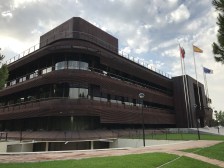Agencies release plan for achieving nanotech-inspired challenge
Several agencies released their collective vision Friday on what they need to do to one day create a computer that can perform brain-like functions with the same energy efficiency as the human brain.
Federal agencies collaborated to release a white paper Friday that not only examines what problems this work could solve for their agencies but also what research and development would be needed to get there. The white paper is the government proposal for tackling what is called the Nanotechnology-Inspired Grand Challenge for Future Computing, which was announced last October.
The challenge was: “Create a new type of computer that can proactively interpret and learn from data, solve unfamiliar problems using what it has learned and operate with the energy efficiency of the human brain.”
This work is the nexus of several of the administration’s initiatives: the National Nanotechnology Initiative, the National Strategic Computing Initiative and the BRAIN initiative.
The National Strategic Computing Initiative celebrated its first anniversary and agencies announced a number of initiatives to drive its work forward Friday, including the white paper, according to a blog by the White House Office of Science and Technology Policy. The goal of that initiative is to expedite the development of high-performance computing in America.
[Read more: White House executive order accelerates use of high-performance computing]
The Nanotechnology-Inspired Grand Challenge aims to get not only government involved in solving the problem but attempts to engage industry, professional societies and academic institutions as well, Lloyd Whitman, assistant director for nanotechnology and advanced materials in the White House Office of Science and Technology Policy, told FedScoop.
The goal is to get a device to do things like see something once and then recognize it again — like the brain — but without having to send that picture to a computer on a cloud that has been programmed already with thousands of pictures, Whitman explained. The challenge is doing something like that but at a much smaller power level than current computing.
“So right now we can do many of these things, these brain-like things but with hundreds of thousands of times more power in current computing,” Whitman said.
The white paper outlines an “integrated approach” to research and development that engages people in both the nanotechnology and computer science fields, along with people who study the brain, Whitman said.
“What’s very interesting about this white paper… is it brought in new people from different parts of different agencies, you know for example, from the computer science side, drafting this document together with people who are very much, you know, nanotechnology or nano-electronics kinds of people,” Whitman said. “And that’s very much what the hope was in announcing the challenge.”
The paper also outlines the technology priorities agencies think the challenge could address, like intelligent big data sensors or smarter cybersecurity systems.
Technical staff from several agencies collaborated on the white paper: the Energy Department, the National Science Foundation, the Defense Department, the National Institute of Standards and Technology and members of the intelligence community.
While the challenge is inspired by nanotechnology, Whitman noted that the solution wouldn’t necessarily have to use it.
But he added that nanotechnology will “very likely” play a role.
Agencies are holding workshops and trying to determine what is the best way to invest to accomplish the goal, Whitman said. He added that people outside the government are also holding meetings and conferences to discuss this challenge.






